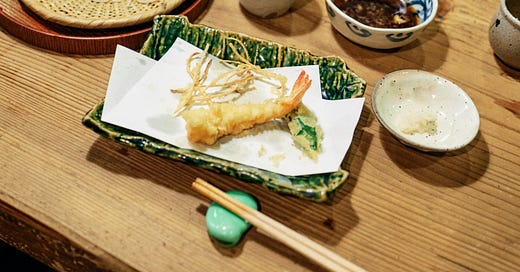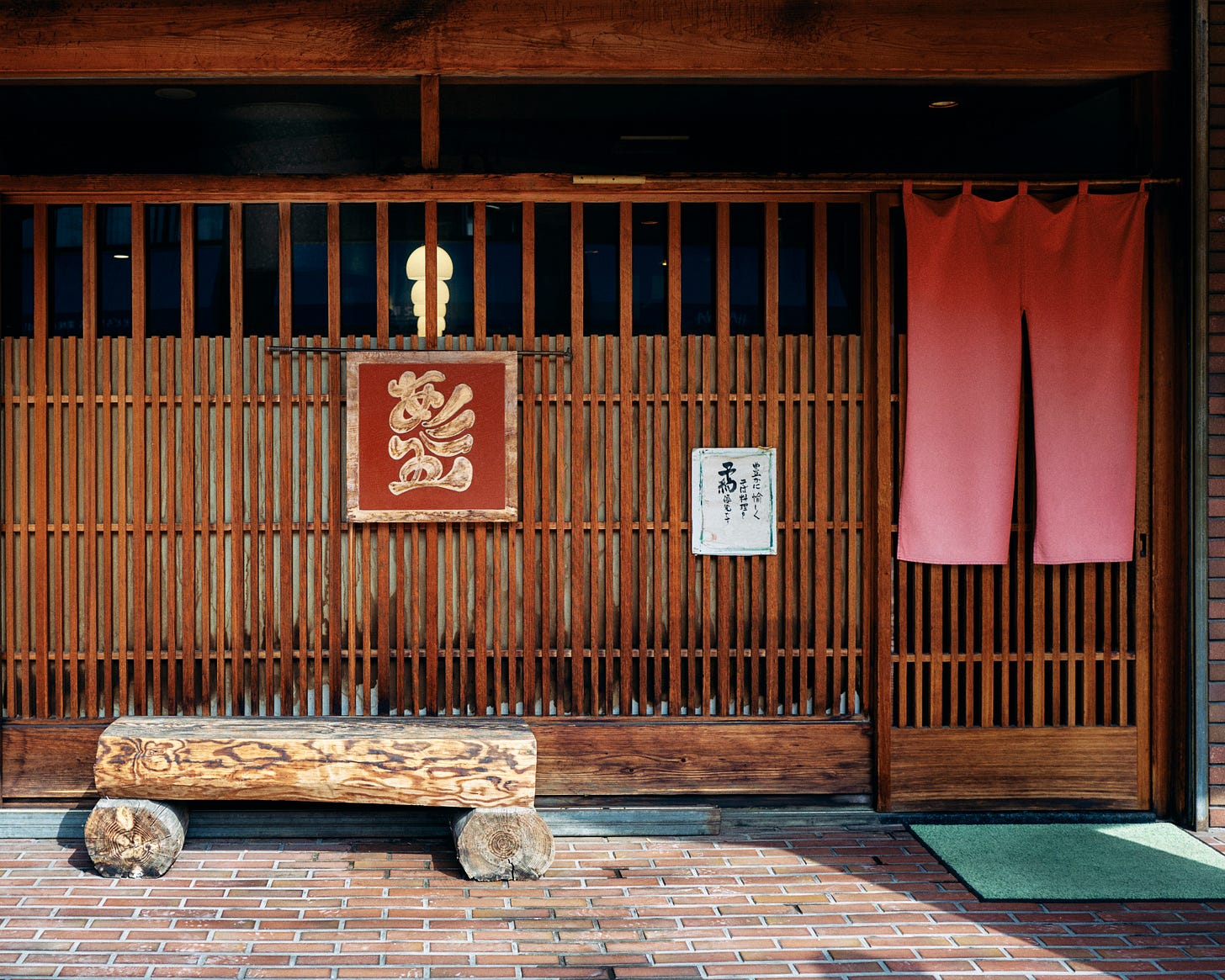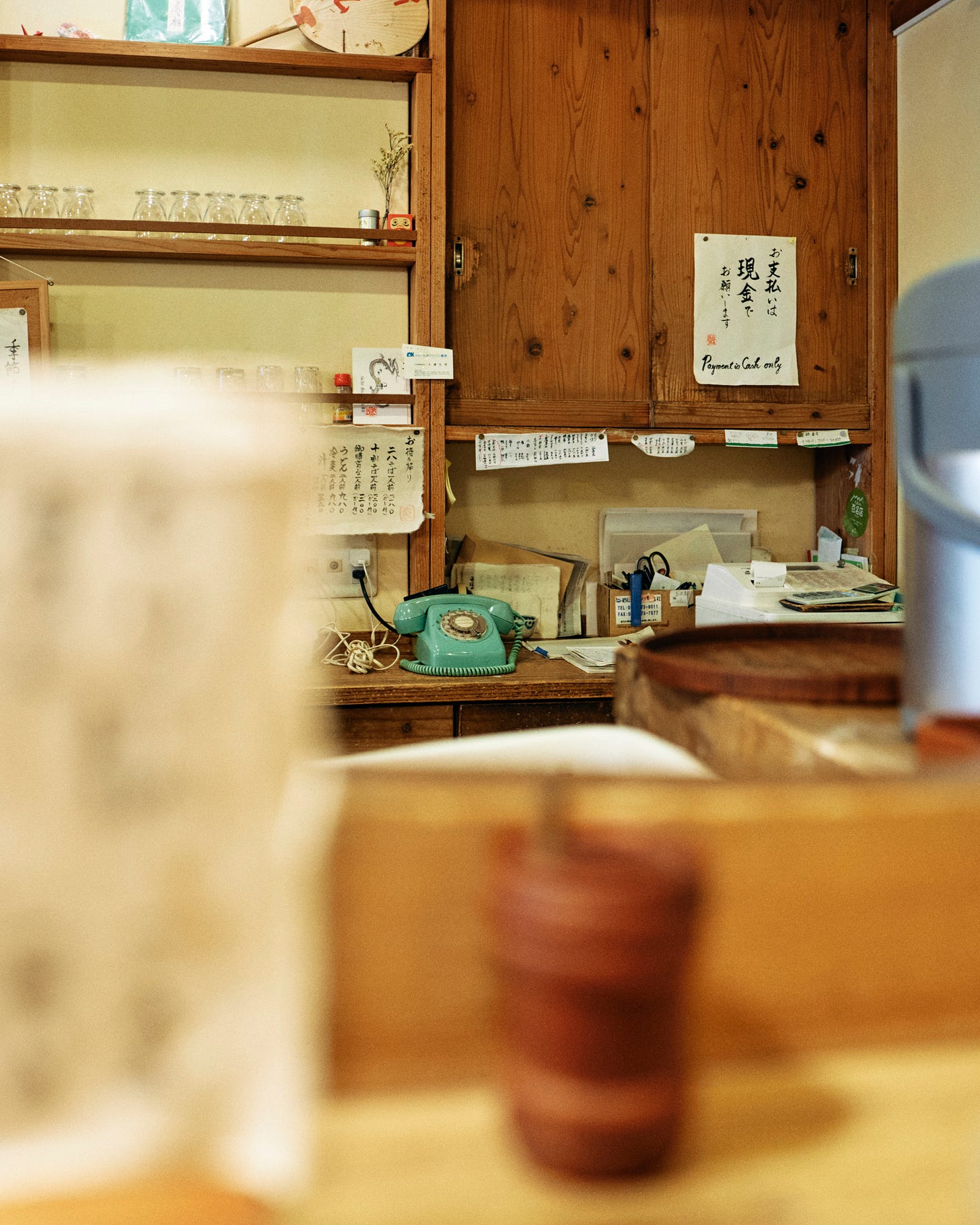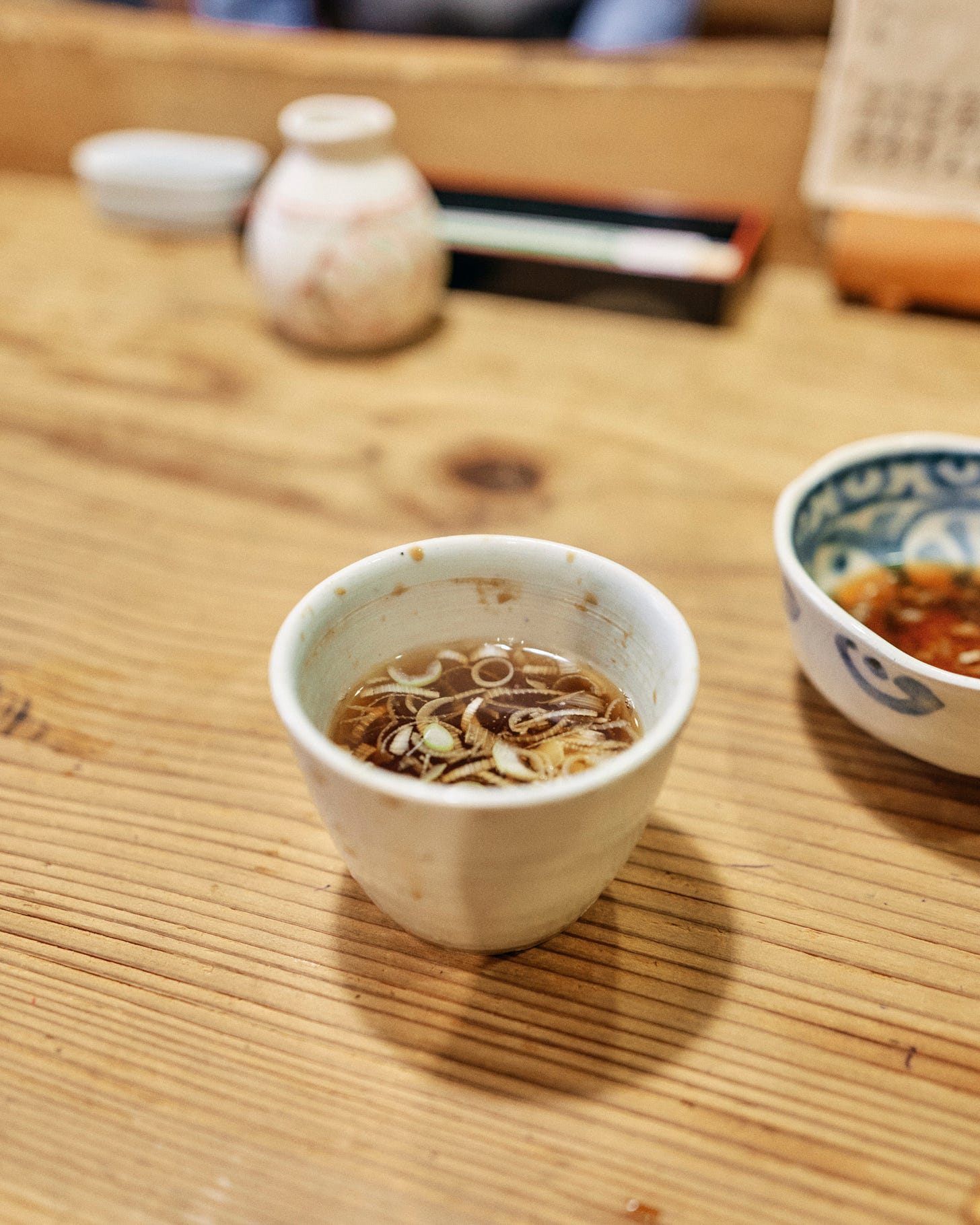The Fixer in Hakata.
For the third time this trip, I caught a train to Hakata.
This time, to buy coffee beans for the family.
Five days to go, 200g should do.
Why not just mail order? Coffee County provides a free drink with every bean purchase, so that’s an incentive.
At 11am, all caffeine up, I had a brief moment of silence.
No errands to run, no friends to meet, nothing to buy.
A medium shot of me standing in front of the Nakasu river, then a wide-angle shot, then an ultra-wide angle shot.
You know that scene in the Solitary Gourmet.
If I remember correctly, Tsuki-ya, the clear broth tonkotsu ramen shop was just around the corner. Since we had it in the airport two years ago, it had exploded and expanded to seven locations, including Ginza.
Merely a block away, I stopped.
If time isn’t an obstacle, why don’t I simply go to my favourite ramen place in Fukuoka?
It’s only two train stops - seven minutes away after all.
I power walked to Tenjin station, took the new Nanakuma line to Yakuin-odori station, past the Royal Host landmark.
I was 200m away.
This time, I know exactly what to order.
100m away.
This time, I wouldn’t get all flustered and order the lukewarm noodles.
50m away.
This time, there’s no queue. Weird.
At the front door.
This time, I found out Mendo Hanamokoshi closes on Wednesdays AND Thursdays.
What the flying piece of cow dung.
It was the middle of the day in the middle of the city, I had no intention of wandering around like when I was in Nishijin.
Times like this, I consulted past-Harvard.
I launch my maps app, and look for ‘emergencies’.
All the places I saved, for situations like this.
I became my own fixer.
Burger? Nah.
Tonkotsu ramen? Only open at night.
Coffee? Not now.
Soba?
Soba.
As I walked towards Asago あ三五, I tried to remember why I bookmarked the place.
Notes from past-Harvard: the only soba place to crack 4.01 on Tabelog. Best in Fukuoka. Top 100 in the country.
Looking at the sign - “priority given to those with reservations”, my heart sank. But the soba gods were merciful, as it wasn’t packed; only a couple of business lunch buddies, and another dating couple. All better dressed than I.
They led me to the end of the corner. Smart.
I asked if I could ‘take a photo’.
“いいよ ii-yo’, the seventy year-old guy said.
This is a restaurant worth flying to from Tokyo.
The owner, Hisao Isobe, is always pursuing the potential of delicious soba and travels all over the country.Isobe-san, the owner of ‘Asago’, regularly publishes soba recipes in his 'Soba Saijiki' series in the Nihon Soba Shinbun (Japan Soba Newspaper), a monthly publication by the Tokyo Noodle Federation Cooperative. He continues to challenge himself with modern variations of ‘Soba Hyakuchin’. You can actually enjoy these menu items at Asago.
- From the blog of カレーパン January, 2023
To be able to feel like you’re in a different place, is a sign of good interior design. To feel like you’re in a different time, is a sign of persistence.
To feel like you’re a better person, now that is magic.
The place is saturated with the smell of sentiments.
Almost all six surfaces of the shop, plus the counter, had timber feature.
The kettle, donabe, the stacked bowls, zaru’s and trays, the telephone, handwritten menu on a plank of wood… are part of the experience.
Drinking my soba tea, I wanted to talk about art. I’d like to write a letter, to my family. Gratitude to my wife. I felt like I could assure my daughter that her future is bright. And we would always play and laugh together.
You won’t feel this while eating ramen because a ramen shop is a fast-food restaurant. Nothing to see here, please eat and leave, as fast as you can. By the way, how loud do you want your IRRASHIAMASE? We will respond with a lounder ARIGATOUGOZAIMASU!!
As much as NHK is trying to portray ramen’s long history, as much as the new wave is trying to make ramen like a once in a lifetime event, ramen is all about serving as many people, in the shortest time, as cheap (or expensive) as possible. You won’t, you can’t bring your in-laws to a ramen restaurant to discuss inheritance.
With the boom of every ramen restaurant, I feel the pain for soba makers.
There is no ‘new wave’ for soba.
No miso base or salt base or pork bone broth to evolve to.
No factory you can pre-order your noodles from.
It’s always an older man, using his hands, kneading soba flour from scratch.
Stock made from kelp and bonito, with soy sauce, wasabi to season.
All local, nowhere to budge.
They aren’t in the pushing business, but rather the ‘pull you back to older times’ business.
This is DNA.
This is heritage.
“I've finally found a soy sauce that satisfies me,” says Isobe-san.
After his favorite soy sauce supplier, which he had used for years, went out of business, Isobe spent almost two years searching for a replacement.“It was in Fukuoka. I used to think Fukuoka soy sauce, with its strong sweetness, wouldn’t suit my soba. But to my surprise, I found one nearby that works perfectly.” He talks about it with a big smile, clearly pleased.
“Soy sauce is the essence of my dishes. If the soy sauce isn’t right, my cooking just won’t work.”
A basic zaru soba starts at 1155 yen (AUD$12).
My tempura prawn and vegetables soba was roughly AUD$28. About three times the price of ramen.
But if we’re talking about the most prestigious soba restaurant in the city, as a last minute, possibly once in life time walk in, to have a guy frying tempura on the spot while the other make soba noodles on the spot?
I don’t want to be that guy, but all soba noodles in Australia, good or awful, start from $25 nowadays.
“The guy with the camera, since you’re taking photos, why not try my soba two ways? One modern, one traditional.” The old man asked me, or ordered me.
“Please,” one of the three Japanese phrases2 I use everyday.
Although I had bookmarked it about four years ago, I hesitated to visit after reading reviews that described it as 'for enthusiasts' or that you will have to listen to the ‘lectures’ from an ‘eccentric soba master'.
- a Tabelog reviewer
“How was it?” He asked later.
“It was great. Soft. The second one was softer,” I spoke as if I had a brain aneurysm.
“Softer yes, but the frangrance is stronger,” I could sense his disappointment in my answer.
Actually, what was the difference between the modern way and traditional way? What soba wheat did you use. Was it the two eight method, or was it the only soba flour? Where was the prawn from? Why did the gentlemen next to me get all the other non-soba dishes?
All the questions I wanted to ask, but could not, due to the distance, and my lack of confidence and comprehension.
After all, I was a guy with a camera.
The shrimp tempura was high quality, but while the owner was working, he mentioned, “The way you're eating (ordering) is against the rules in our restaurant,” and explained that it would throw off the balance of what’s served later.
From there, we started discussing, “What’s the difference between tempura served at a soba restaurant and tempura from a specialized tempura shop?”
I thought, ‘this is interesting’, and soon after the conversation turned to, ‘Do you eat vegetables?’
At that point, I said, “I’ll leave everything up to you from now on. Just bring me all the delicious things!”
To which he replied, “That’s the way it’s done here”, and the meal resumed.- a blogger from Osaka, 2014
Just before I finished I realised there was a different menu in the middle of the counter.
This wasn’t a soba noodle restaurant, but a soba restaurant.
They serve full courses of soba - soba flour with grated yam, soba sushi, soba bun, fried soba …
Was the young guy / front of house inexperience to not push the course menu, or he assumed that I would not be able to appreciate it, hence giving me the ala carte menu?
He was probably right.
If I couldn’t tell the difference between the new way and old way of cooking soba, how would I possibly be able to appreciate a full course?
Was the shop all hype?
I’m not entirely sure. I don’t eat enough soba to know.
The noodles weren’t as gritty as the traditional soba. A hint of sweetness. I wasn’t sure if the dipping sauce was too intense, or the noodles were too delicate.
On their YouTube channel, there’s only one video:
To say the website, social, branding and promotion are amateurish is almost a praise. They’ve been around for twenty years now. Customers are flying in from Tokyo, if anything, it’s the opposite of hype. Pure uncles in polo tshirts. Almost like you can’t not give this guy the highest accolade in the country for being such a soba nerd.
As I sip on my soba-yu, the hot starchy water after cooking soba, mixed with the leftover tsuyuu (dippping sauce) with a hint of kabosu citrus, I felt aptly nourished.
Not exactly hungry, but not full enough to hate myself like my last few ramen encounters.
I also thought about a headline by a publisher to promote a book:
“Read it, before you fully become an adult”.
I kinda get it now.
There are things you can only appreciate when you’re younger, without the constraints of reality, expectation, and failures.
Physically, I remember downing two bowls of ramen consecutively, the first time I visited Tokyo, twenty years ago.
I have developed a foresight not to do that with age.
Perhaps, on my final day in Hakata, the universe together with my own time travelling were telling me that I’m too old for ramen.
I appreciated the hint.
Maybe next time, we can try the kaiseki course together.
The highest-ranked ramen restaurant in the whole of Tokyo sits at 3.97.
The other two - ‘Sorry’, ‘Thank You’.











